Powering your home, vehicle, farm, or cabin with solar energy has never been cheaper. But more options make the switch complicated. Knowing the major differences between them will make your choice easier — and can save you money.
Are you thinking about “going solar” but unsure what that term really means?
Here you’ll discover the basic differences between your “going solar” choices:
- On-grid (or grid-tied)
- Off-grid (stand-alone with or without battery backup)
- Hybrid (sometimes called “solar + storage”)
These differences fall into the following categories:
- Energy source
- Power storage
- Electricity supply during grid failures
- Energy costs and billing
- Tax breaks and other incentives
In this article we’ll go through everything you need to know to determine the best solar option for your situation.
On-grid solar system
In an on-grid solar system, photovoltaic (PV) panels are connected to the utility grid. During the day, the solar modules supply your home with electricity. The solar array could be rooftop or ground mount.
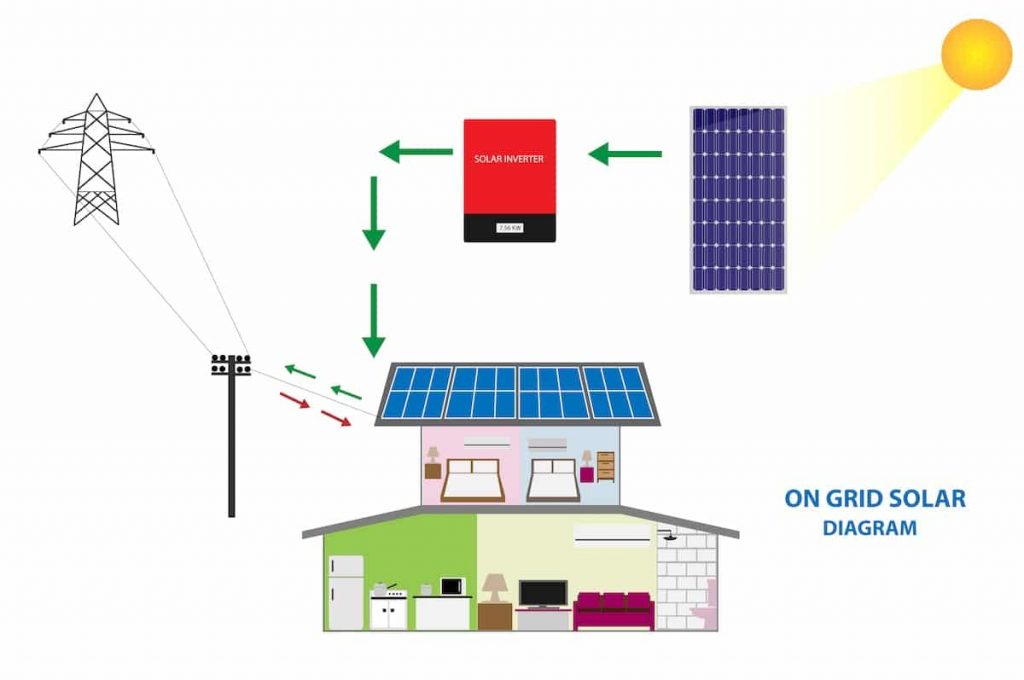
Before purchasing an on-grid solar system, it’s important to determine how large of an array you need to meet all of your home energy needs. Online tools, like the PVWatts Calculator from the National Renewable Energy Laboratory (NREL), make the math easy for you.
During the solar panel installation, the PV modules are connected to an inverter. There are several types of solar inverters on the market, but they all do the same thing: convert the direct current (DC) electricity from the sun into the alternating current (AC) that you need to run most household appliances.
At times when your energy demands are higher than what your panels supply, like at night or on cloudy days, the utility grid delivers electricity into your home.
If your solar array produces an excess of electricity that you don’t consume, it’s sent to the power grid as AC to supply other homes or businesses. In jurisdictions in the United States where net metering exists, homeowners receive a bill credit for the surplus.
Whether individuals eligible for net metering receive retail or wholesale rates varies from place to place. Later, homeowners “redeem” their credits when they use grid electricity because their solar array is not generating enough energy to meet demand.

However, it’s not correct to think that the utility provides you with a “free” form of solar storage through net metering. You pay a fixed monthly fee for access to the power grid – whether you actually use this service or not.
In some places, electric companies may charge higher rates during peak demand times. Homeowners with solar may soften the sting of higher costs during peak daytime demand because of their solar array offsetting the need for utility electricity.
Since you are connected to the grid, however, power outages also shut down your PV array. This prevents electricians repairing the transmission lines from getting hurt or killed by live voltage sent by your panels.
U.S. states vary widely in the number and extent of federal or state tax breaks, rebates, and other incentives for home solar. For an average U.S. home in 2020, a 6kW solar installation project costs approximately $17,000 (after the federal tax credit).
Through the end of 2020, the federal solar tax credit is equal to 26% of the total installation cost. In 2021, this credit drops to 22%. It will expire after that unless reauthorized by Congress.
Check out DSIRE, the Database of State Incentives for Renewables & Efficiency, for all the latest information on how you can save on switching to solar energy in your state, as well as our own guide to save money on solar installation.
Off-grid solar system
DIYers and people yearning for complete energy independence may choose a stand alone solar array. This off-grid system has no connection to the utility power grid.
Off-grid is also suitable for folks living remotely, far from power lines, since the cost of installing transmission and distribution cables is prohibitive by comparison.
People with many unique electrical installation needs, such as in a barn, tool shed, fence, RV, boat, or cabin, find off-grid solar perfect for them, too.
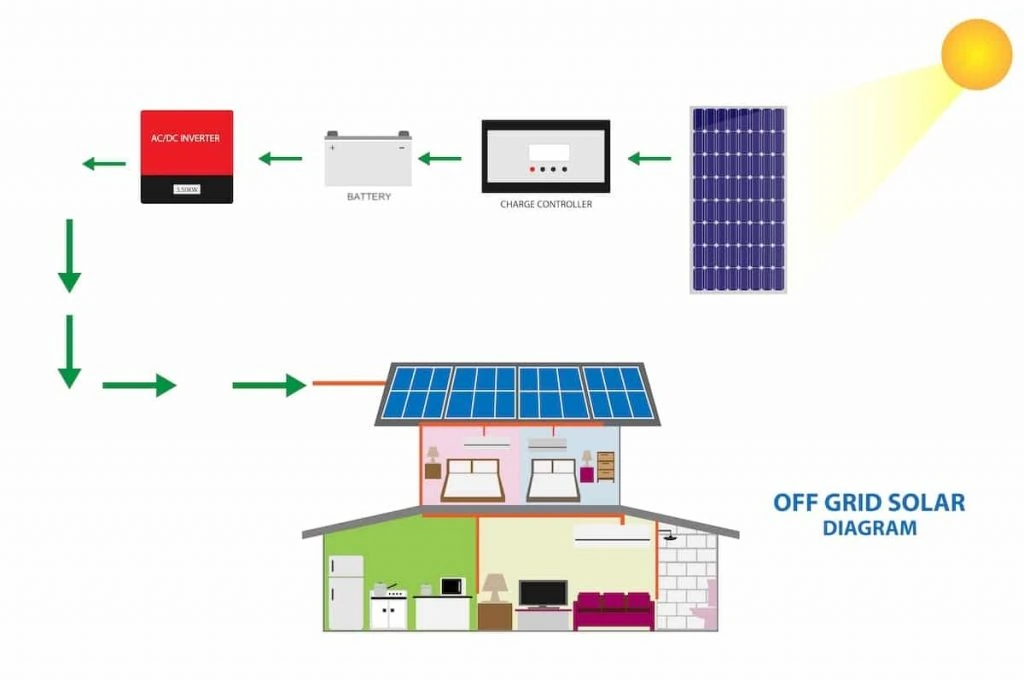
Because stand alone systems have no connection to the grid, whatever solar energy your PV cells capture – and you can store in batteries is all you have for power. That is, unless you have another renewable energy source or a fossil fuel-driven generator.
Some people who live off-grid like to combine solar with wind by installing residential wind turbines. The logic is that when there are clouds that decrease solar production, wind is likely going to take up the slack.
Individuals considering off-grid solar must calculate their power needs for a specific length of time (often several days at least).
If not, you could wind up without power for an extended period — and there’s no grid to save you.
The upside of off-grid solar, of course, is that you never receive an electric bill!
There are several online calculators to use when figuring out how much electricity you need to power all the appliances you’d like to. The total amount determines the appropriate size for your battery pack (if you decide to use one). A battery pack is just an interconnected set of batteries.
The battery pack can be expensive. Consumers will pay around $400-$750/kWh in 2020, although the total cost could be much higher for the highest-quality brands.
Another way of looking at it is that, on average, solar batteries cost between $200 and $2,000 each depending on their capacity to store energy. A typical battery pack for an off-grid system could include 12 batteries.
Many companies offer off-grid solar panel kits which have all of the items you need to setup your own off-grid system.
Off-grid systems require a charge controller
A necessary component of off-grid + storage solar is the charge controller, located between the PV modules and the battery pack. The charge controller protects the battery life in several ways.
First, this device limits the amount and rate of charge that your batteries receive during the day to prevent overcharging. It also stops the batteries from draining back toward your panels at night.
Lastly, a charge controller is equipped with a low voltage disconnect. This means when the battery is almost fully drained, the controller cuts off power to your appliances. Upon recharging, it will turn them back on. This feature prevents damage to your batteries caused by over-drainage.
There are two main types of charge controllers on the market today: PWM and MPPT. The ideal one for you depends on your PV array’s voltage, your load (that is, all your appliances), and the voltage of your battery pack.
In most cases of off-grid solar, where the PV modules are at a significantly higher voltage than the battery pack, the MPPT controller is the better choice.
Because of the larger size of an off-grid solar system needed to power an entire home for several days, weeks, or even months, the cost of this type of system is often astronomical, easily reaching $50,000 or more. It could be considerably less if you do thorough research for the best prices and install it yourself. With developments in PV and battery technology, the upfront costs are decreasing.
Residential off-grid solar projects are also eligible for federal and state tax credits. Since all of the batteries are charged only by renewable energy, they qualify for tax credits as well.
However, if you use a backup generator running on fossil fuels to charge your battery pack occasionally, you will not be able to receive full credit for your battery investment.
Hybrid solar systems can combine be best of both worlds
A hybrid solar system — also called “solar + storage” — combines features of both on- and off-grid solar. These systems are connected to the utility grid. So, when your panels can’t meet your home’s electrical demands, energy from the grid kicks in to keep you up and running.
Your modules can send excess energy back to the grid. They also are connected to a battery pack to draw on during power outages when the grid is down. In theory, the battery backup could be charged by either your solar panels or the grid.
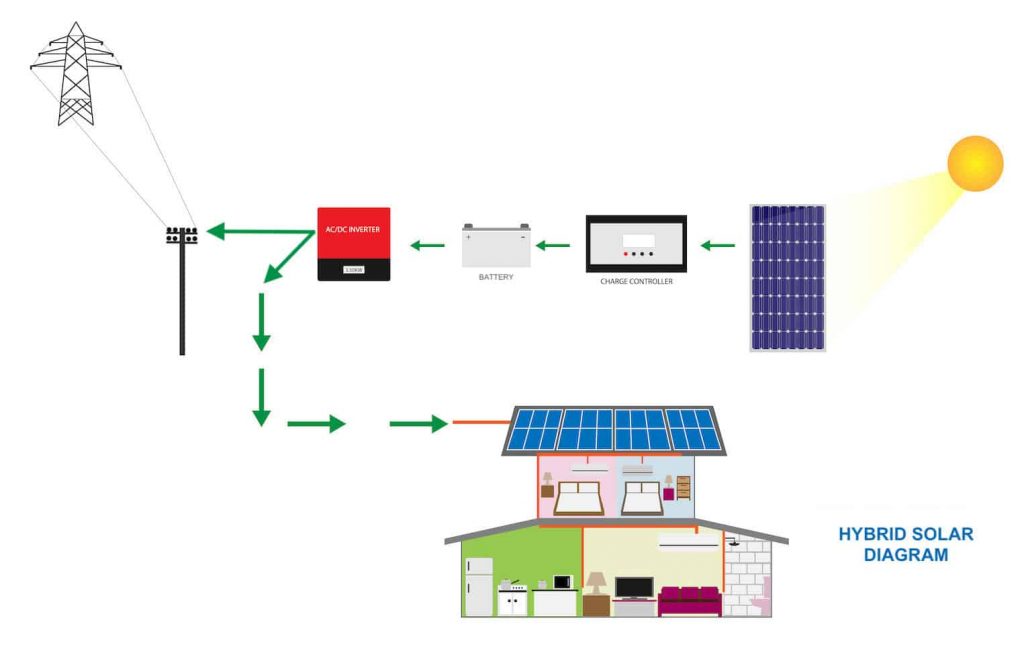
Ever since Tesla’s Powerwall hit the market, green consumers wanting to cut off all ties with their electric company — for either economic or ethical reasons — thought they had their solution.
Not so fast. Solar batteries are still costly — upwards of $12,000 for a single battery with a 13.5 kWh capacity. (By comparison, your home uses about 30 kWh per day.) So, several batteries easily doubles or even triples the cost of the average solar system for a home in the United States.
Keep in mind that batteries usually come with a 10-year warranty. Meanwhile, your PV modules may continue to generate electricity for a decade or two after that.
If you choose to maintain solar storage, you will need to replace your batteries at least once during the life of your solar energy system. It is prudent to figure in this additional cost upfront so you won’t be caught by the “surprise” expense later.
The battery pack added to your grid-tied solar setup significantly lengthens the payback period (after which your system starts to make money for you). This period varies widely depending on where you live and the cost of electricity, but estimates range between 5-10 years to recoup your upfront costs.
In contrast, the average energy payback time is 4 years or less.
Despite the added cost, experts predict batteries will become standard with every residential solar installation in the U.S. by 2025.
Currently, AC- and DC-coupled batteries are available for all solar systems, including hybrid arrangements. Homeowners seeking to upgrade their grid-tied system to include storage usually choose AC-coupled batteries.
By contrast, people installing new solar energy systems + storage tend to go with the higher-performing (and less expensive) DC-coupled variety.
Like the case for off-grid solar, full eligibility for all government tax incentives for your hybrid system depends on the percentage of battery charging from your PV modules versus the utility grid.
Pros and cons of the 3 major types of home solar systems
Here’s a summary table of the major considerations to take into account when you’re deciding which solar setup is right for you. Because total costs differ widely depending on the size of your system and your unique situation, the table presents only a qualitative assessment.
| Solar System | Initial Financial Investment | Payback Period | Energy Independence | Battery Storage |
|---|---|---|---|---|
| On-Grid | Moderate | Short | No | No |
| Off-Grid | Greatest | Longest | Yes | Usually |
| Hybrid | Significant | Long | No | Yes |
Wrap up on differences between grid-tied, off-grid, and hybrid solar systems
There are many aspects to consider when choosing the best solar system to meet your needs.
People looking for complete energy independence, or those in remote locations, may opt for off-grid solar with or without battery storage.
The most economical for average consumers looking to go green and save on home power costs — given the current state of the market — is grid-tied solar. You’re still connected to the utility, but largely energy-sufficient. Note that if power outages are short and infrequent, you may experience some inconvenience.
However, if you live in a wildfire-prone area or one that is at high risk for hurricanes, a hybrid system may be worth considering. In an increasing number of cases, electric companies are shutting down power for extended and frequent periods — by law — for public safety reasons. Those dependent on life-supporting appliances may not be able to cope.
The day will come soon when solar batteries aren’t so expensive. Then, a hybrid solar system will be worth it even for average homeowners who want to do their part for future generations by investing in renewable energy today.




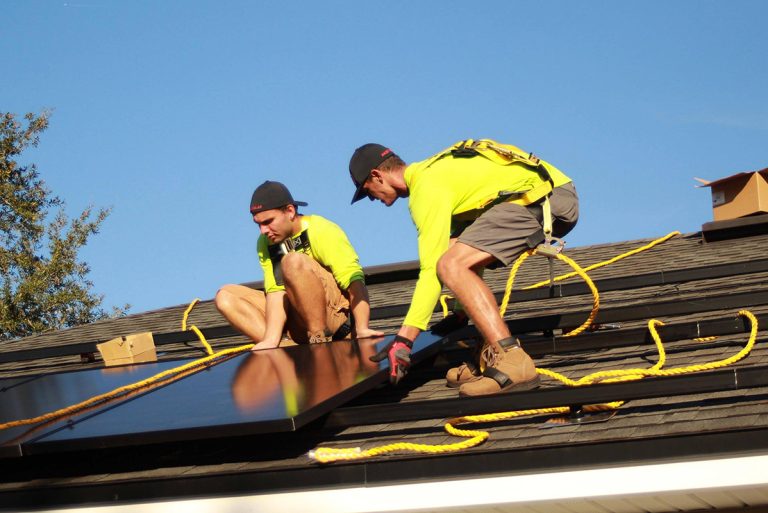
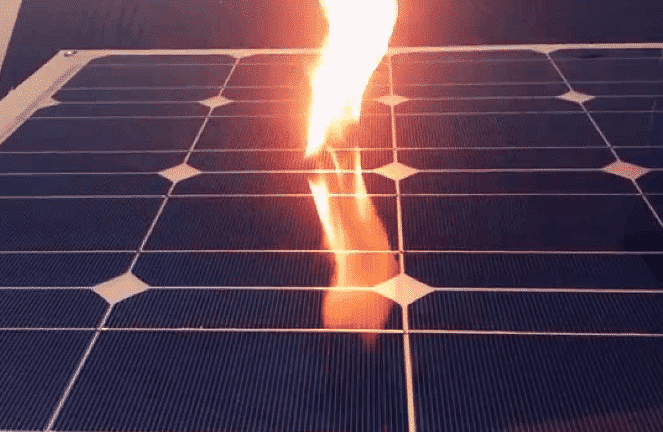

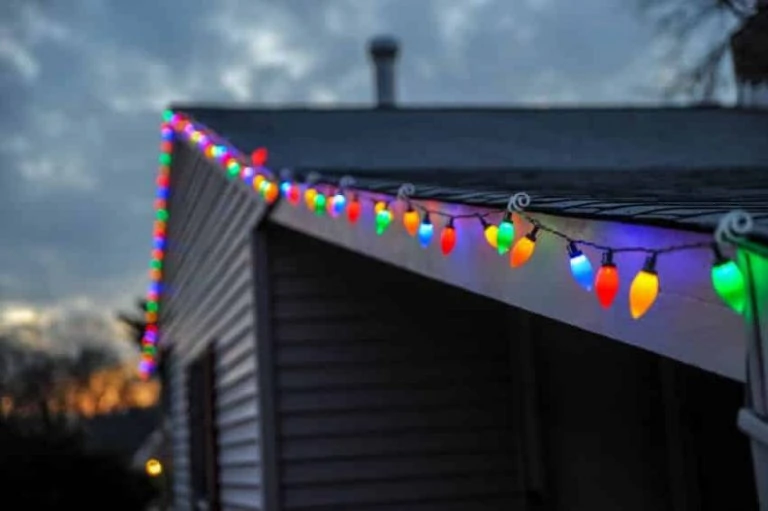

![Eco-Worthy Solar Panel Review 2024 [Includes Buyer’s Guide]](https://greencoast.org/wp-content/uploads/2019/02/Eco-Worthy-Review-and-Buying-Guide-e1574180788859.jpg)


